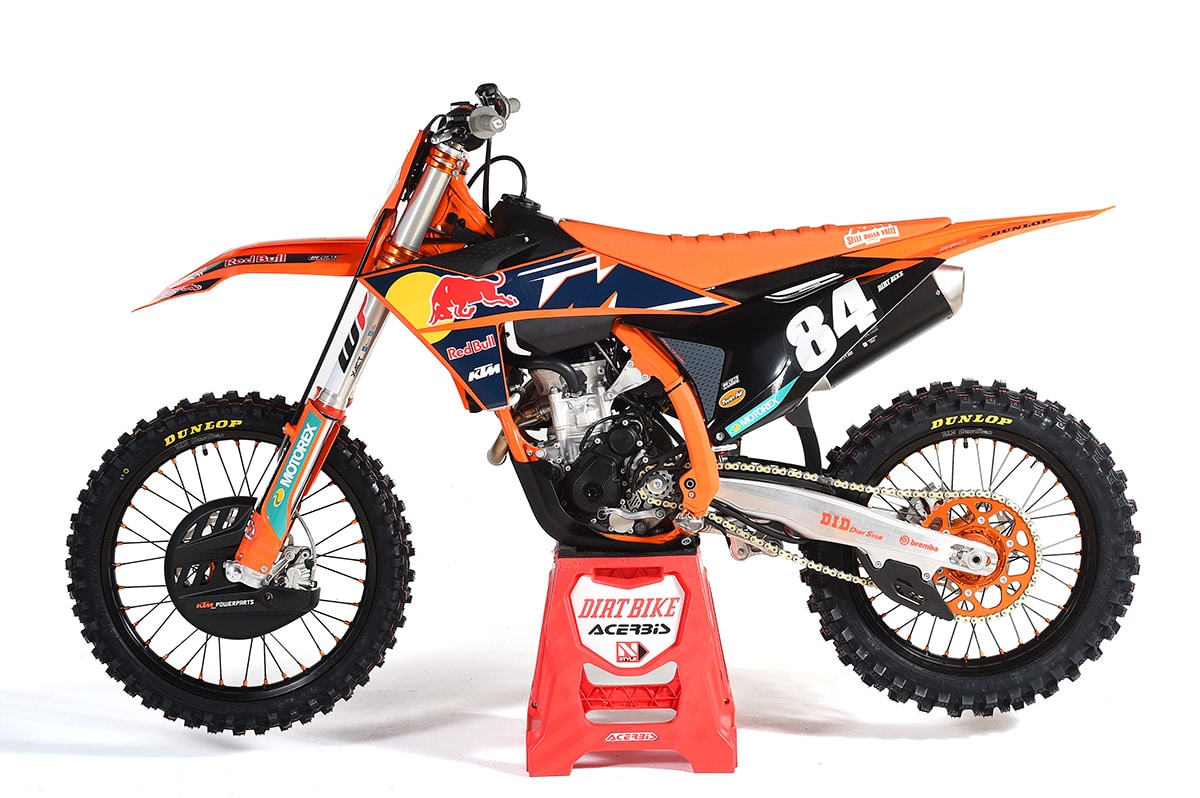KTM’s 250SX-F Factory Edition is the most dramatic revision of any model in the company’s line in 10 years. It is, technically, a 2022 model, but as we all know from past experience, this will be the basis for the 2023 standard edition. It will also be the basis for the GasGas and Husqvarna 250 competition bikes as well as the 350s. So far, we have two days of riding on the new bike, and we have used the standard 2022 KTM 250SX-F as a measuring stick as well as the 2022 Yamaha YZ250F that won our 250 Shootout. Rather than list the parts that have changed (which is all of them), here’s a brief run-down on the thinking behind the changes.

Frame: it’s still a steel frame, but the engineers spent a great deal of time addressing flex characteristics. The central backbone used to extend from the steering head all the way back to the top shock mount. Now, it’s more of a wishbone connecting to the swingarm pivot. The top shock mount is on a tower directly connected to those frame members above the swingarm. The thinking is that this allows front end flex and rear suspension flex to be addressed and fine-tuned independently. The frame is obviously beefier and heavier.
Motor: The bore and stroke configuration has changed (81.0 x 48.5mm as opposed to 78.0 x 52.3mm). That contributed to a more compact package, which has 8mm less overall height. The head is much wider and the cams are farther apart. KTM says the motor has been rotated down in the rear 2 degrees to make the countershaft sprocket 3mm lower. They say that reduces squat under acceleration.
Suspension: The shock is new, mostly to fit into the space allowed. It’s 20 mm shorter, although rear suspension travel is still 300mm. The fork is once again the WP Xact air fork. The “Hydrolock” system is gone and the valving is revised.
New features: The bike now features Quickshift, which is usually found on street models. This interrupts the ignition momentarily on upshifts (not including the shift to second gear). It can be disabled through a new switch on the handlebar. That switch also has two maps, traction control and launch control. The footpegs are new (larger) and the bodywork is integrated much better. In the rear, the bike’s asymmetrical bulge for the exhaust is gone. There’s a bulge on both sides now.

Factory Edition features: KTM likes to dress up the Factory Edition with Red Bull graphics and other upgrades. These include orange anodized billet hubs, split triple clamps, a disc guard, a skid plate and a gripper seat cover. This year, it does not include an aftermarket exhaust or clutch cover.
Most of those Factory Edition parts are heavier than the standard items. Overall, the bike is almost 10 pounds heavier than the standard edition. Our new Factory Edition is 228 pounds without fuel on our scale. The standard 2023 model will doubtlessly be lighter than the FE, but KTM engineers freely admit that the new frame is heavier than the old one.

Testing the new bike is a big job, because it’s sooo different. Initially, it seems like a different brand of motorcycle. Most of that comes from the change in bodywork, shape and gripping points. Once you get past that, certain similarities become clear. The power delivery isn’t that different. The new bike has more power, but only slightly, and the increase in power is across the entire powerband. On top, the peak is still substantial, but less raspy. When it hits the rev-limiter, it hangs there without much sputtering. The difference between the two maps is more noticeable than ever. The top map (it doesn’t have a number as much as a position on the switch and a bluish-colored light) has the most mid-range power and is better at partial throttle openings. The lower map (greenish) is best when the throttle is wide-open.
Quickshift is interesting. It helps in a very narrow window of circumstances. If you hold the throttle wide open in soft terrain and yank the shifter up as you hit peak power, it makes the shift a little less jerky. That exact combination of conditions doesn’t happen often on any given lap. After the start, upshifts might not be at full throttle or peak power for most riders. Sometimes an upshift is to just lower the rpm on a jump face or in whoops. There, you only notice a hiccup in the sound of the motor, but there’s no real advantage. So far, we haven’t noticed any real disadvantage to Quickshift, but we will have to circle back after more testing. You can turn the feature off if you like.

As far as overall handling, the bike is more stable in a straight line. Some riders say that it’s less compliant in turns, but in the big picture, the KTM has always been magnificent in turns and still is. The bar set by the previous model is very high. In the suspension department, the bike has a similar feel, which isn’t that surprising. The KTM’s most dramatic characteristic has always been all about the air fork with its distinctive traits. We fully expected the bike to be more harsh and rigid-feeling because of the stiffer frame, but so far we’ve been surprised and pleased that this isn’t the case. We still have a very long way to go in order to become familiar with this bike, but at this point we’re impressed and happy. The full test will be in the May 2022 print issue of Dirt Bike.
See you next week!
–Ron Lawson





Comments are closed.